MXA RACE TEST: THE REAL TEST OF THE 2022 KTM 250SXF
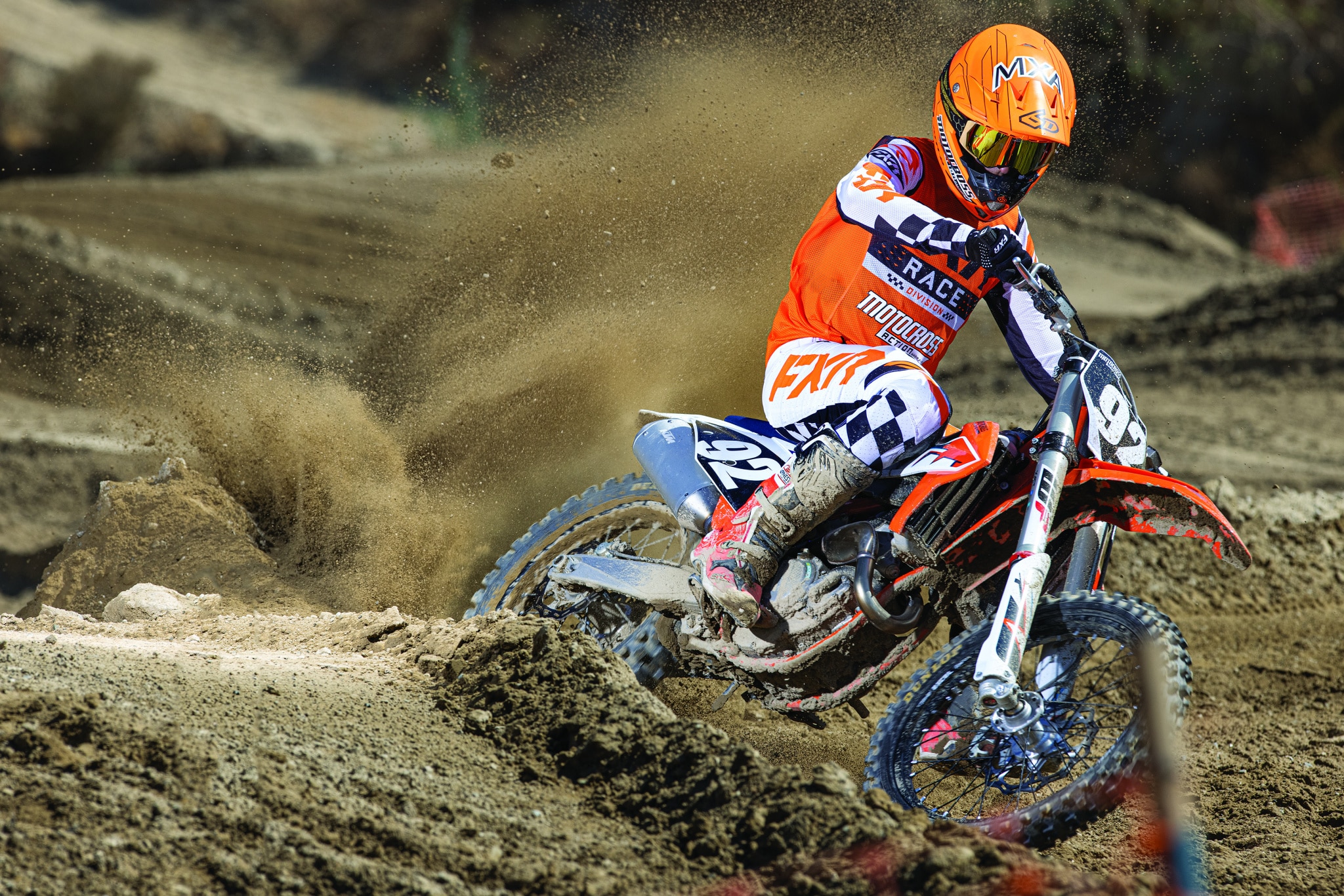 THE GEAR: Jersey: FXR Racing Revo Flow, Pants: FXR Racing Revo Flow, Helmet: 6D ATR-2, Goggles: EKS Brand Lucid, Boots: Alpinestars Tech 10.
THE GEAR: Jersey: FXR Racing Revo Flow, Pants: FXR Racing Revo Flow, Helmet: 6D ATR-2, Goggles: EKS Brand Lucid, Boots: Alpinestars Tech 10.
Q: FIRST & FOREMOST, IS THE 2022 KTM 250SXF BETTER THAN THE 2021 MODEL?
A: Not that we can tell on the track. The only internal mod to the engine was replacing the needle bearing on the counter-balancer shaft with a plain bearing—actually a bushing. KTM personnel said the needle bearing to plain bearing swap was done because the needle bearing had a proclivity to walk out of the cases. There are two other changes that are more cosmetic than mechanical. First, the radiator shroud graphics are bolder and have a 3D look. Second, the frame color has been changed from black to orange. The frame color change is exciting, because it looks more like the factory bikes, but, more significant, the last couple of times KTM made its production frames orange it was as a precursor to the new model coming the next year. You can bank on the 2023 KTM 250SXF being all new, including the engine, frame, running gear, swingarm, plastic and axles. And that fact presents a conundrum for any potential 2022 KTM 250SXF buyer: Do you wait for an all-new bike, or stay with a very refined version of something that is tried and true?
Q: WILL THE 2022 KTM 250SXF WIN MXA’S 2022 250 FOUR-STROKE SHOOTOUT?
A: No. Emphatically no. How can we be so sure? Since the 2022 KTM 250SXF is a virtual clone of the 2021 model, it is mathematically impossible for the 2022 KTM 250SXF to win. Why? Simply because it lost the “2021 MXA 250 Four-Stroke Shootout” to its cousin, the 2021 Husqvarna FC250. That begs the question of whether it will keep its second spot on the podium. We know by logic it will be close. The Kawasaki KX250, GasGas MC 250F, Husky FC250, Suzuki RM-Z250 and Yamaha YZ250F are all basically the same bikes for 2022. The only bike that got a major makeover is the 2022 Honda CRF250. But, the 2022 Honda seems to be focused on beating out the Yamaha YZ250F as the best of the bikes with strong low-to-midrange powerbands. That is not an arena that the KTM 250SXF needs to worry about. However you cut it, the Honda will play a major round in 2022 250 Shootouts.
KTM has a better reputation with its first year models than Honda; however, KTM doesn’t have a perfect track record, as it has introduced closed-off air boxes and mapping issues in recent history. Doing the math, we can safely predict that the worst spot the 2022 KTM 250SXF can land on in the “2022 MXA 250 Four-Stroke Shootout” is third.
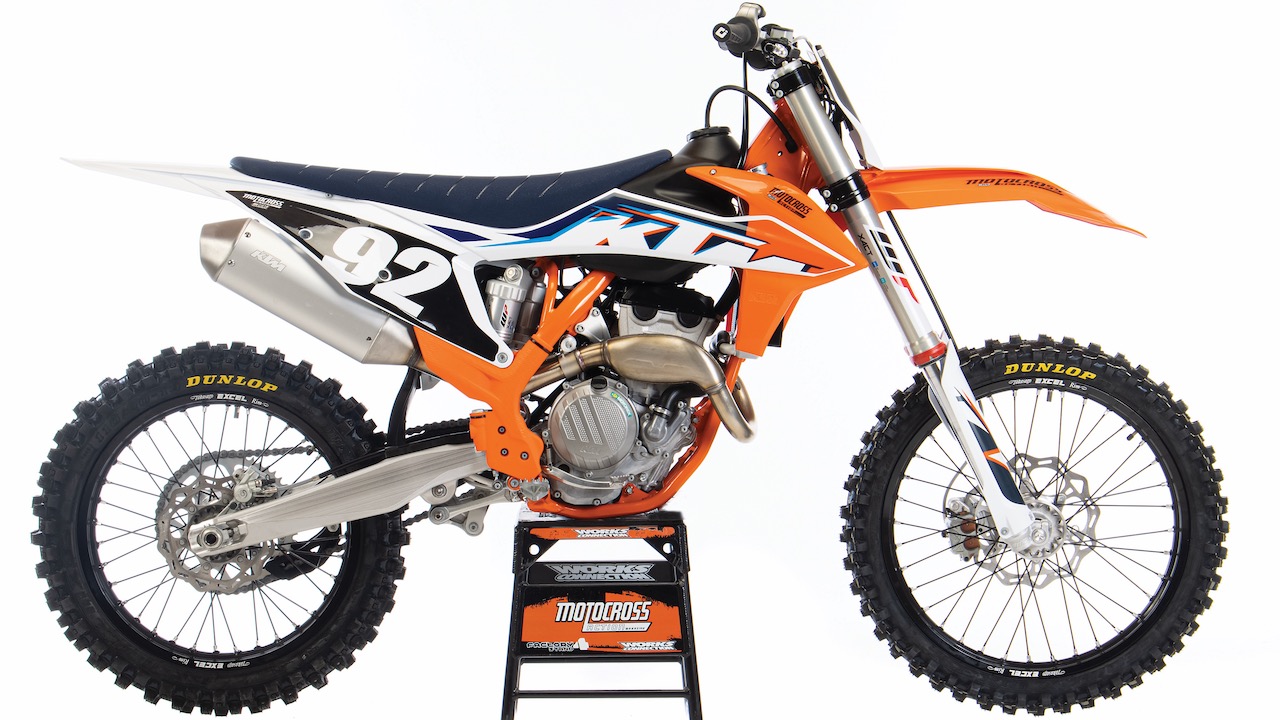 The 2022 KTM 250SXF is a refined package with a powerful engine and good suspension that is riding on a superb chassis.
The 2022 KTM 250SXF is a refined package with a powerful engine and good suspension that is riding on a superb chassis.
Q: HOW FAST IS THE 2022 KTM 250SXF?
A: Obviously, people who spent their hard-earned money on other brands don’t like to hear this, but the Austrian powerplant, although six years old, is the best engine in its class. This is a proven fact based on dyno runs and seat-of-the-pants comparisons. It has the broadest powerband in spite of its tall 14/51 gearing. It’s only weakness is that it doesn’t feel like it revs quickly to its 14,000-rpm peak. That is easy to fix.
We will be the first to admit we have been complaining about KTM 250SXF gearing since this generation of 250SXF engine premiered in 2016; however, in 2016, the stock gearing was much lower with a 13/50 combination. This is what we wrote about 250SXF gearing in 2016: “On tight tracks, we geared the bike down with a 51-tooth sprocket to get to third gear sooner. Paradoxically, on bigger tracks, we preferred to gear the bike up with a 49-tooth rear sprocket.” Then, in 2017, KTM made the switch to a taller 14-tooth sprocket (that it still uses in 2022). We hated the taller overall gearing because it made the low-to-mid transition feel like it was on Ambien. Test riders complained that since the 2017–2022 KTM 250SXF had the most horsepower from low-to-mid, it shouldn’t take so long to get going. We found the perfect way to shut them up. We swapped the 14-tooth countershaft sprocket for a 13. This was like adding three teeth to the rear sprocket. That may sound like it would be too low, but don’t worry, it just erases the effects of the 14-tooth countershaft and goes back to the gearing we liked in 2016. This is a race-setup gearing change. It will pull harder off the bottom than the YZ250F, which is geared at 13/50, and feel like it pulls even longer on top. If you think changing the countershaft is too drastic, try going one or two teeth bigger in the rear.
We hear over and over again that the 250SXF is a top-end-only engine. It is a screaming, go-for-broke, top-end engine, but it is also a really good low-to-mid engine. The big 14-tooth countershaft sprocket makes the 250SXF engine slow to get moving. It feels sluggish out of tight turns. A new countershaft sprocket can let it run with the bulls.
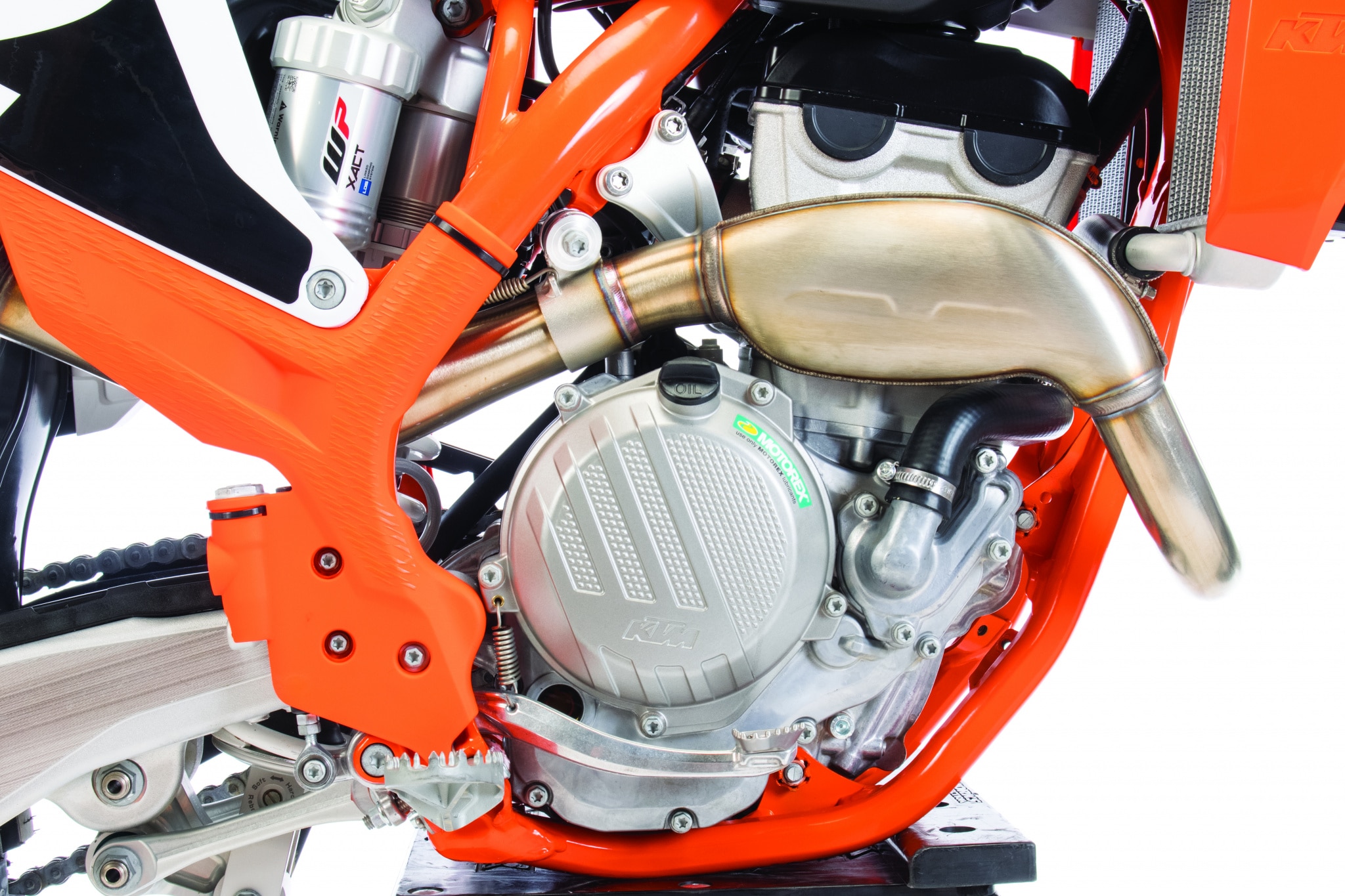 The KTM 250SXF engine is a complete package.
The KTM 250SXF engine is a complete package.
Q: WHAT DO WE REALLY THINK OF THE WP SUSPENSION COMPONENTS?
A: They are really good. Last year was a big year for WP because they had a breakthrough with their air fork technology. On the track, the WP XACT air fork felt more like a spring fork than most production spring forks. The new WP forks tracked the ground better and the hyper-progressive spring rate curve at the end of the stroke was mellowed out.
If it is your first rodeo with air forks, there is a learning curve; however, it is much less of a learning curve than five years ago when there were confusing Showa and Kayaba air forks with three different air chambers. The KTM WP XACT air fork has one Schrader valve to put air in or take air out. The right fork leg is strictly damping, and the left leg is air only. KTM even puts a sticker on the air leg to guide you to its recommended air pressure. It is a very good starting point, but it’s just a suggestion, not an ironclad law. It is in your best interest to check your fork pressure every day, just as you check your tire pressure.
The air pressure you put into your fork is just a replacement for the steel coil springs in other forks. The difference is that you can adjust the air pressure in minutes to make the spring rate stiffer or softer. You can’t do that with a coil spring. The stock 152 psi (10.5 bar) air pressure was on the stiff side for our Novice, Vet or light riders. We have slower or lighter riders that run as low as 140 psi, but most of our test riders stay within the 150 to 152 psi range and adjust the compression clicker to find their sweet spot. On a side note: most of our testers slide the forks up into the clamps to deliver a better feel at turn-in without the side effects of head-shake.
There isn’t much to say about the shock, which is a good thing. We set the sag at 106mm, and our test riders only made minor clicker adjustments. The stock setting is very good and works well with the forks.
 The WP XACT forks are workmanlike.
The WP XACT forks are workmanlike.
Q: WHAT DO WE THINK ABOUT THE 250SXF HANDLING?
A: For starters, the 250SXF is carrying around a minimum of several fewer pounds than its Japanese competition (and in some cases ten pounds less). The bike is light, and you can feel it when riding. The chassis dimensions allow you to have your cake and eat it too. It can turn with the best in the class and is still stable at speed. The handling took a big step forward with the update to the WP XACT forks in 2021. This made the bike feel more connected to the rider and the ground.
For less-skilled riders, dialing in the handling can be on the touchy side in comparison to the YZ250F or CRF250, meaning you need less rider input to achieve the same thing. That may sound like a good thing (and it is for most riders), but some riders want the bike to do more of the work, which the YZ250F does; however, in a tough situation, everyone wants the quick feedback of the 250SXF.
Q: WHAT DID WE HATE?
A: The hate list:
(1) Sprocket. We don’t understand how they haven’t fixed this issue yet.
(2) Spokes. Like the sprocket bolts, the spokes come loose, especially the ones next to the rim lock. It is ridiculous that this is still a problem.
(3) Bleed screws. Please change the fork’s bleed screws from Torxs to Phillips screws.
(4) Preload ring. The plastic preload ring needs to be beefed up, because if you use a hammer and screwdriver to move it, the ring gets notched out. We pry a flat-blade screwdriver against the frame when loosening the collar to minimize damage. If you have the money to buy the Xtrig preload adjuster, do it. It is awesome!
(5) Fork adjuster. The thin and short compression clicker starts to hurt your fingers after a few clicks. We like the fact that you can adjust the rebound damping by hand, but it isn’t finger-friendly either.
(6) Gearing. The tall 14/51 gearing gives a false impression of what the engine is capable of.
(7) Loose bolts. All bikes have bolts that come loose under the rigors of motocross. On the 2022 KTM 250SXF, we pay attention to the head-stay bolts, lower subframe bolts and rear shock linkage nut.
(8) Wiring. The starter-button wire pulls out of the white junction box behind the front number plate, and the FI idiot light falls out of its plug-in rubber holder under the top triple clamp.
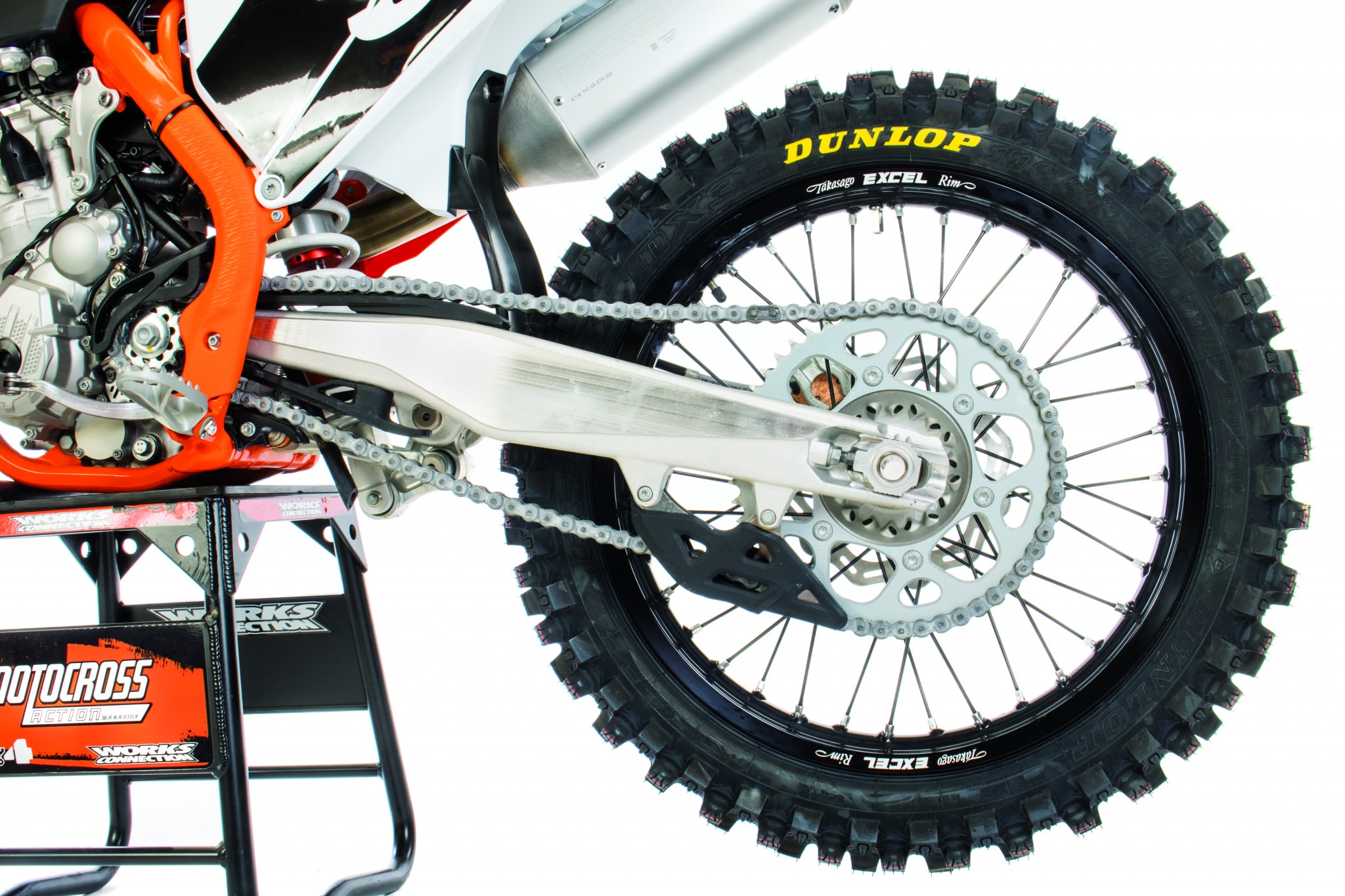 If the engine feels slugish, go with lower gearing.
If the engine feels slugish, go with lower gearing.
Q: WHAT DID WE LIKE?
A: The like list:
(1) Weight. The 2022 KTM 250SXF is the second-lightest 250 four-stroke in its class next to its cousin, the GasGas MC 250F, at 218 pounds.
(2) Brakes. The KTM’s Brembo brakes are way ahead of their class.
(3) Air filter. This no-tools airbox and plug-in air filter cage make changing an air filter such a simple task that you might actually do it.
(4) Hydraulic clutch. Having a self-adjusting bulletproof clutch means one less thing you have to think about.
(5) Power. The 250SXF offers the most complete powerband in the class hands down.
(6) Ergonomics. This is an easy bike to feel comfortable on.
(7) Suspension. The XACT air forks are getting better each and every year. They are better than most of the spring forks on the market.
(8) Vented airbox. The optional vented airbox cover is free power.
(9) Maps. KTM’s electronic suite offers multiple maps for different terrain. If you are a hardcore racer like us, you will only need Map 2.
(10) Grips. The lock-on ODI grips are comfortable and are much easier to change than the vulcanized grips some manufacturers still use.
Q: WHAT DO WE REALLY THINK?
A: We find it hard to believe that the Japanese brands haven’t been able to dethrone an Austrian bike with a six-year-old engine in it. Over those six years, the KTM 250SXF has won the MXA 250 four-stroke shootout five times. The one time it lost was in 2021 when it got beat by the Husqvarna FC250, which has the exact same six-year-old engine in it. The 2022 KTM 250SXF engine package is supported by an awesome clutch, powerful brakes, slick shifting, light weight, resilient chromoly frame and really good suspension. We have to wonder what the all-new 2023 models will bring to the table.
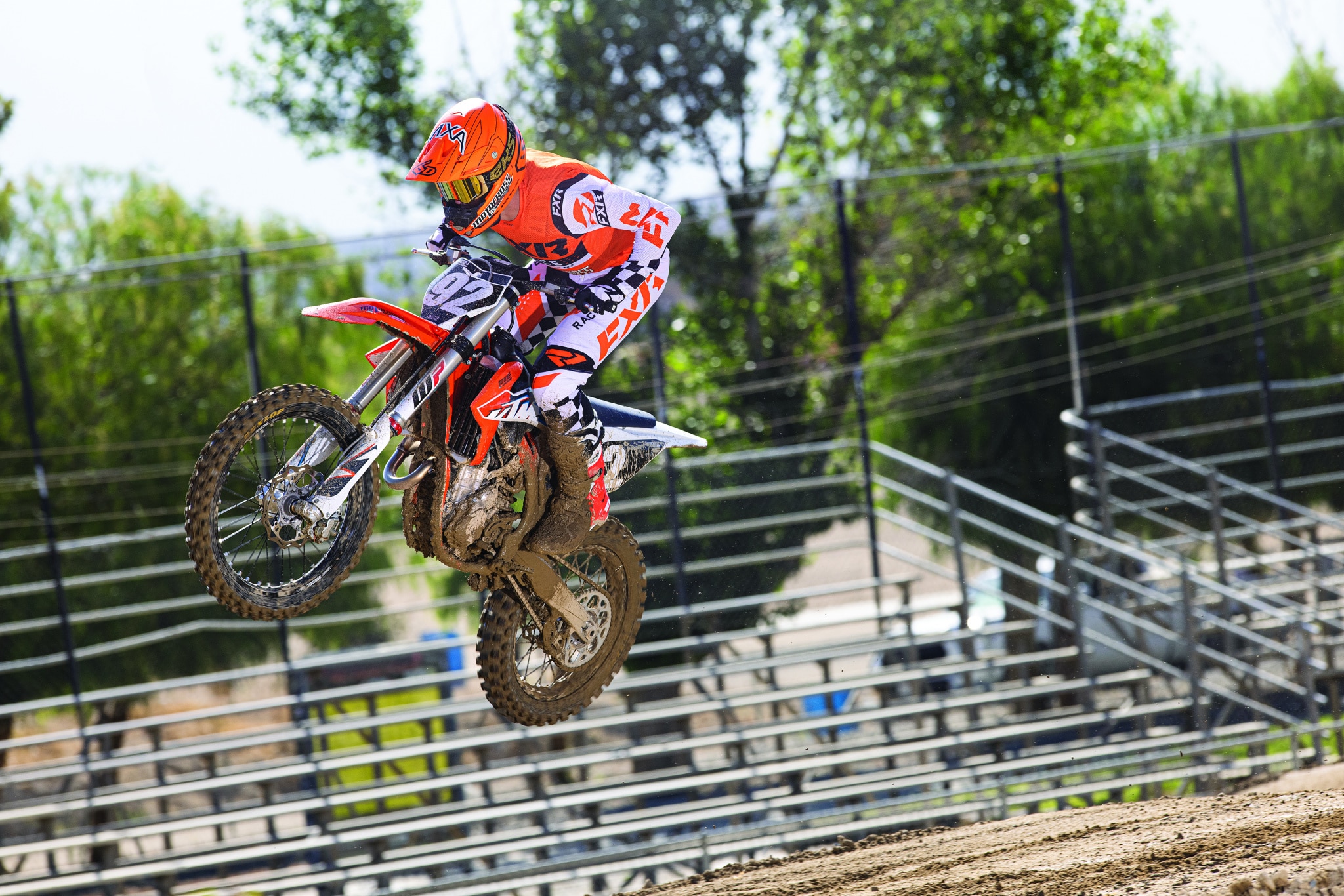 The KTM 250SXF is agile in the air, as well as in the corners.
The KTM 250SXF is agile in the air, as well as in the corners.
MXA’S 2022 KTM 250SXF SETUP SPECS
This is how we set up our 2022 KTM 250SXF for racing. We offer it as a guide to help you find your own sweet spot.
48MM XACT FORK SETTINGS
The stock KTM air fork setting is 152 psi or 10.5 bar. The stock pressure worked well for most of MXA’s test riders. The faster testers even went up a few pounds, while slower testers went as low as 140 psi. Most riders could find their sweet spot with the stock air pressure by just adjusting the compression clicker. Those who went up on pressure tended to go out on the compression a few clicks. All MXA test riders preferred the feel of the Husqvarna FC250’s 10mm-shorter fork specs and, in an effort to replicate this feel, we slid the forks up in the clamps to the fourth line and ran the rear sag at 107mm. We got the KTM close to the Husky feel, but found it hard to match Husqvarna’s purpose-built, 10mm-shorter forks; it was still worth the try. For hardcore racing, we recommend the fork setting below for an average rider on the 2022 KTM 250SXF (stock specs are in parentheses):
Air pressure: 152 psi
Compression: 10 clicks out (15 clicks out)
Rebound: 15 clicks out
Fork-leg height: Third line
Notes: Remember to check the desired air pressure every time you go out and ride. We also suggest bleeding those pesky air screws after every ride. They can build up air fast and have adverse effects on your ride.
WP SHOCK SETTINGS
Overall, this is a good shock. Although we do make clicker adjustments, we rarely stray far from the stock 15 clicks out on compression. It can be dialed in with only a few clicker changes. As a rule of thumb, most MXA test riders leave the low-speed compression on the stock setting alone and focus on the high-speed dial to make the changes. For hardcore racing, we recommend this shock setup for the 2022 KTM 250SXF (stock specs are in parentheses):
Spring rate: 45 N/mm
Race sag: 106mm
Hi-compression: 2 turns out
Lo-compression: 15 clicks out
Rebound: 15 clicks out
Notes: We couldn’t replicate the 1-inch-lower rear end of the Husqvarna FC250 without changing the complete shock linkage and shortening the shock’s shaft travel. Dropping race sag to 107mm and dropping the forks to the fourth line could get closer to the Husky setup.


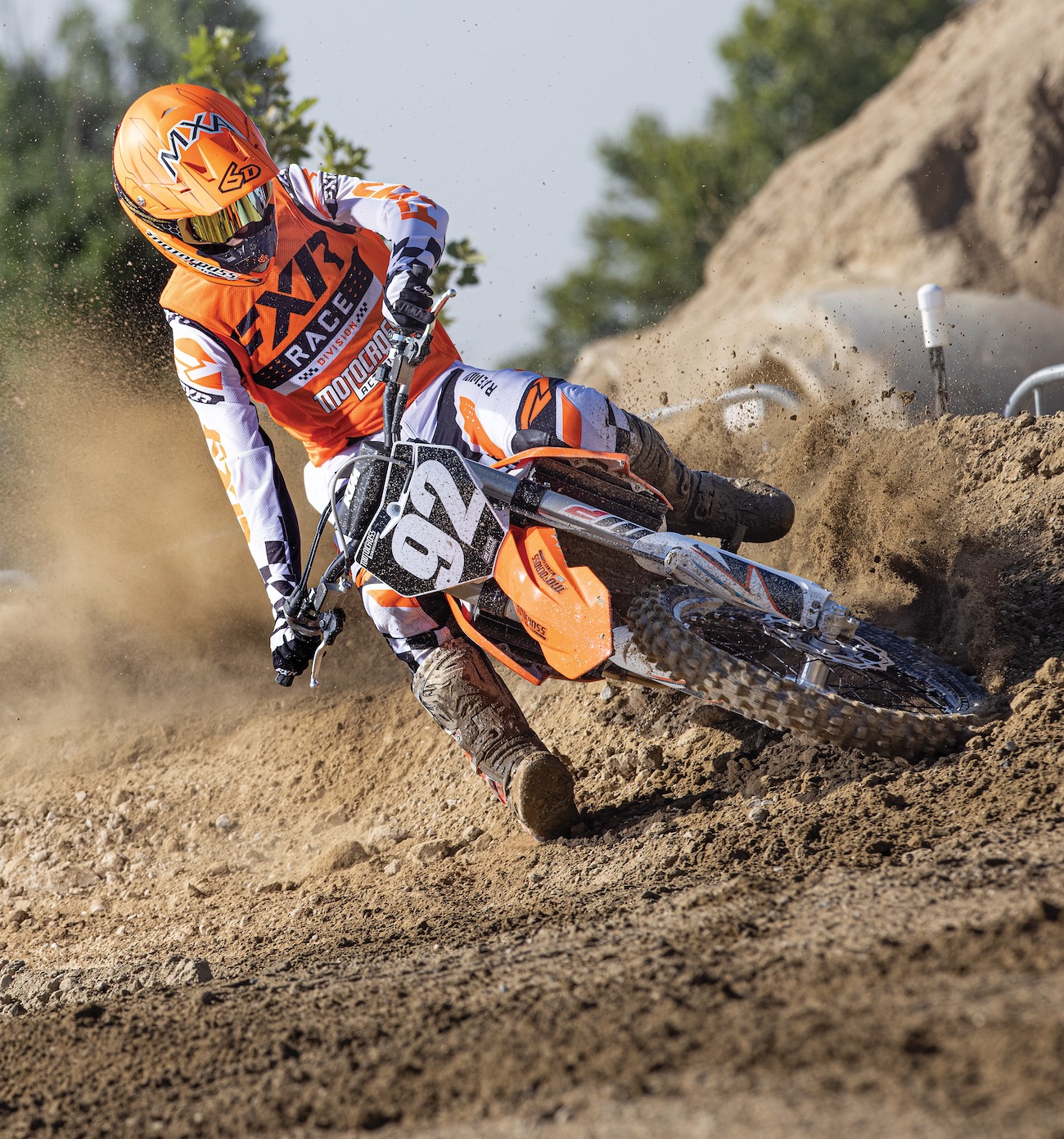
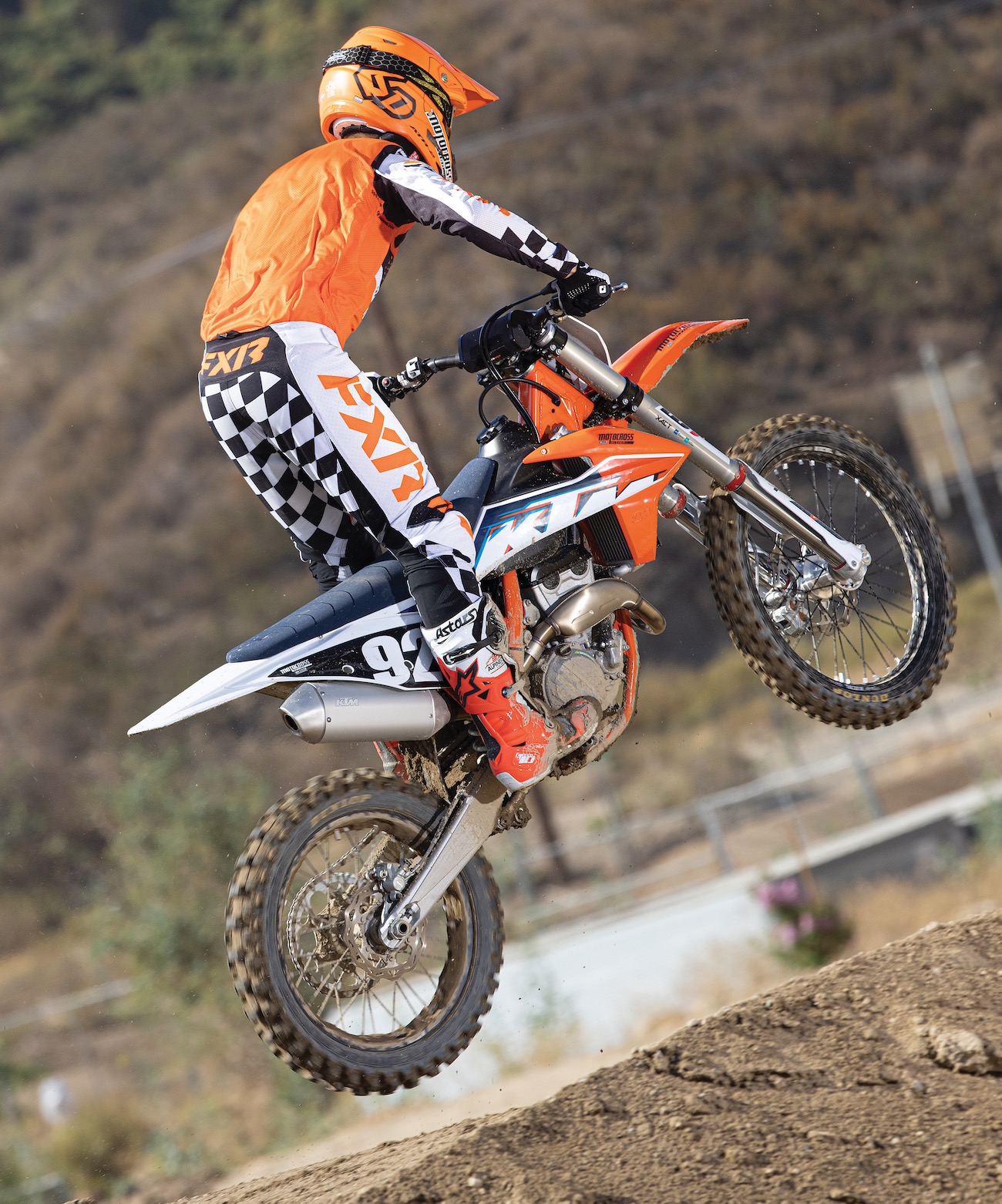




Comments are closed.